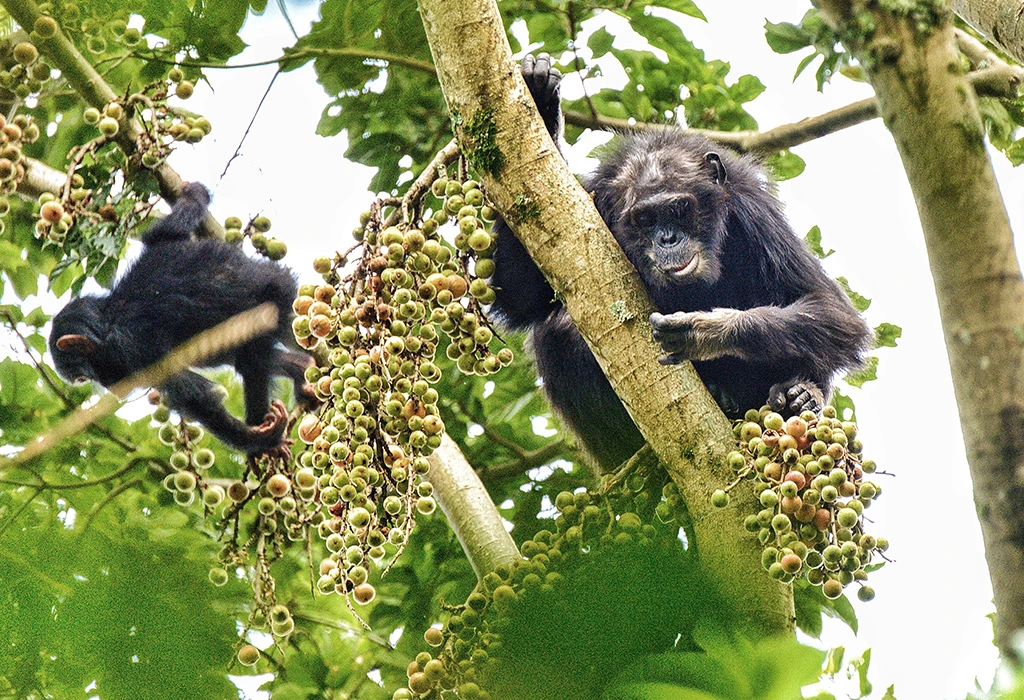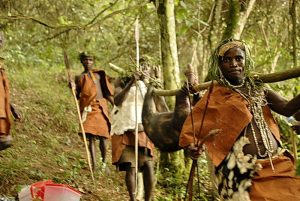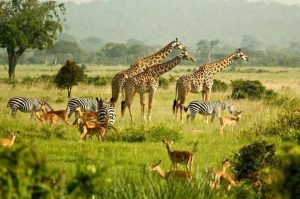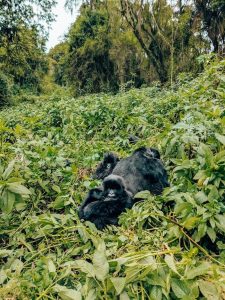Nyungwe Forest National Park, located in southwestern Rwanda, is a biodiversity hotspot and one of Africa’s oldest montane rainforests. Spanning over 1,000 square kilometers, this lush expanse is home to a remarkable array of flora and fauna, including 13 primate species. Among these, the eastern chimpanzee stands out as a primary attraction, drawing visitors worldwide to experience the thrill of chimpanzee trekking in their natural habitat. Chimpanzee Trekking in Nyungwe Forest
What Makes Nyungwe Forest Ideal for Chimpanzee Trekking?
Nyungwe Forest’s dense canopy and rich biodiversity create an optimal environment for chimpanzees. The park is home to over 500 chimpanzees, with two habituated groups available for trekking. The forest’s varied terrain, ranging from bamboo-covered slopes to dense rainforest, provides both a challenging and rewarding experience for trekkers.
How Do You Obtain a Chimpanzee Trekking Permit?
To participate in chimpanzee trekking, visitors must obtain a permit. The cost varies based on residency status: foreign non-residents pay $150, foreign residents $75, and East African citizens $25. These permits include park entry fees and the services of professional guides. It’s advisable to book permits well in advance, especially during peak travel seasons, to secure a spot on the trek.
When Is the Best Time for Chimpanzee Trekking in Nyungwe?
Nyungwe Forest experiences a tropical climate with rainfall throughout the year. However, the dry seasons—from June to September and December to February—are generally preferred for trekking due to more favorable trail conditions. During these months, the forest is less muddy, making hikes more manageable. Conversely, the wet seasons (March to May and October to November) offer lush vegetation and increased fruit availability, which can lead to more stationary chimpanzee groups, potentially enhancing sighting opportunities.
What Should You Expect During the Trek?
Chimpanzee trekking in Nyungwe is considered moderately challenging. The forest’s terrain is characterized by steep slopes, dense vegetation, and altitudes ranging from 1,600 to 2,950 meters above sea level. Treks can last anywhere from 2 to 6 hours, depending on the location of the chimpanzee groups. Participants should be in good physical condition and prepared for strenuous activity. It’s also important to acclimate to the altitude and stay hydrated throughout the trek.
What Should You Pack for the Trek?
Proper preparation enhances the trekking experience and ensures safety and comfort. Essential items include:
-
Sturdy Hiking Boots: Waterproof boots with good ankle support are crucial for navigating slippery and uneven trails.
-
Long-Sleeved Shirts and Trousers: These protect against insect bites, thorny vegetation, and sun exposure.
-
Rain Jacket or Poncho: Given the rainforest environment, sudden downpours are common, making waterproof outerwear essential.
-
Insect Repellent: To guard against mosquitoes and other insects prevalent in the forest.
-
Gardening Gloves: Useful for hand protection when navigating through dense vegetation.
-
Reusable Water Bottle: Staying hydrated is vital during the trek.
-
Snacks: Energy-boosting snacks can be beneficial during long treks.
-
First Aid Kit: Include basics like bandages, antiseptic wipes, and personal medications.
-
Camera with Zoom Lens: To capture distant wildlife without disturbing them.
What Is the Minimum Age for Chimpanzee Trekking?
To ensure the safety and well-being of both visitors and chimpanzees, the minimum age for chimpanzee trekking in Nyungwe is set at 15 years. This age restriction helps maintain a controlled and respectful environment during treks.
How Close Can You Get to the Chimpanzees?
Once a chimpanzee group is located, trekkers are allowed to spend up to one hour observing them from a safe distance of approximately 8 meters. This guideline minimizes stress on the animals and reduces the risk of disease transmission. During this time, visitors can witness a range of behaviors, from grooming and feeding to social interactions, offering a profound glimpse into their daily lives.
Where Can You Stay Near Nyungwe Forest?
A variety of lodging options cater to different budgets and preferences:
-
Luxury: One&Only Nyungwe House provides high-end amenities and stunning rainforest views.
-
Mid-Range: Nyungwe Top View Hill Hotel offers comfortable accommodations with panoramic vistas.
-
Budget: Gisakura Guest House provides affordable lodging close to the park’s entrance.
Staying near the park allows for early starts on treks and the opportunity to immerse oneself in the serene forest environment.
How Does Chimpanzee Trekking Compare to Gorilla Trekking?
While both experiences offer unique insights into primate behavior, there are notable differences:
-
Chimpanzee Trekking: Chimpanzees are more active and move swiftly through the trees, making sightings more dynamic but sometimes more challenging.
-
Gorilla Trekking: Gorillas tend to be more stationary, allowing for longer and often closer observations.
Both experiences are enriching, offering distinct perspectives on primate life in Rwanda’s forests.
What Other Wildlife Can You Encounter in Nyungwe Forest?
Nyungwe’s rich biodiversity extends beyond chimpanzees. The park is home to 13 primate species, including the Ruwenzori colobus, which can form troops of up to 400 individuals—the largest known primate groupings in Africa. Other notable primates include L’Hoest’s monkey, grey-cheeked mangabey, and the owl-faced monkey.
Bird enthusiasts will find Nyungwe a paradise, with over 300 bird species recorded, including 30 Albertine Rift endemics. The forest also shelters numerous mammals, reptiles, amphibians, and a vast array of butterflies, making it a haven for nature lovers and researchers alike.
How Do You Book a Chimpanzee Trekking Permit?
Permits can be obtained through the Rwanda Development Board (RDB) or authorized tour operators. Given the limited number of daily permits and the popularity of chimpanzee trekking, it’s advisable to book well in advance, especially during peak travel seasons. Tour operators often offer comprehensive packages that include permits, accommodation, transportation, and guided treks, simplifying the planning process for visitors.
What Health and Safety Precautions Should You Take?
To ensure a safe and enjoyable trekking experience, visitors should adhere to the following guidelines:
-
Vaccinations: Ensure routine vaccinations are up to date.
-
Insect Protection: Use insect repellent to guard against mosquito-borne illnesses.
-
Hydration and Nutrition: Carry sufficient water and energy-rich snacks.
-
Medical Kit: Bring a personal first aid kit, including any necessary medications.
-
Respect Wildlife: Maintain a safe distance from animals and follow the guidance of park rangers at all times.
Conclusion
Chimpanzee trekking in Nyungwe Forest National Park offers an unforgettable adventure into one of Africa’s most pristine ecosystems. The experience combines physical activity with the profound reward of observing chimpanzees in their natural habitat. Beyond the trek, Nyungwe’s rich biodiversity and commitment to conservation provide a deeper appreciation for the delicate balance of nature. Whether you’re a seasoned traveler or a first-time visitor to Rwanda, a journey into Nyungwe promises memories that will last a lifetime.




